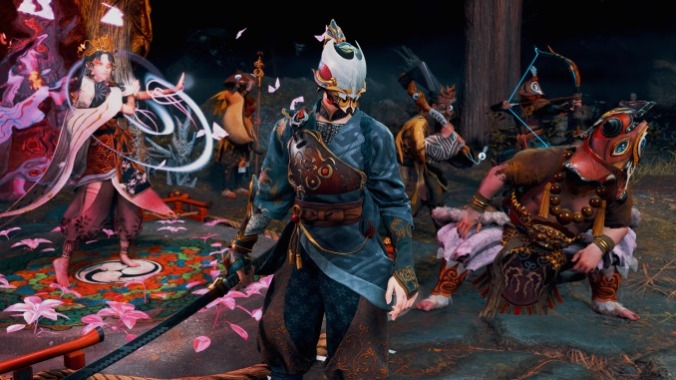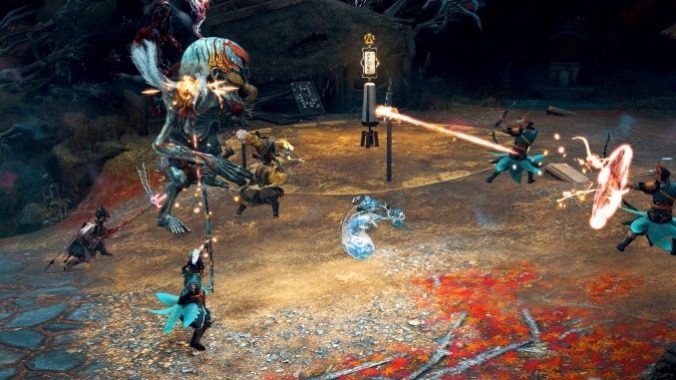Dance the Blight Away in Kunitsu-Gami: Path of the Goddess

All the Goddess wants to do is dance! Her villagers and soldiers, too. And even the supernatural warrior who protects her and gives orders to her citizen militia during battles against an omnipresent evil presence known as the Seethe that has corrupted their home of Mt. Kafuku. (That warrior’s the one you play as, natch.) Kunitsu-Gami: Path of the Goddess might be a tower defense-y, hackin’ ‘n’ slashin’ strategy game based on Japanese folklore, but dance is at its heart and all over the screen when you play it.
Let’s fill out that dance card. Soh, the mighty warrior you play as, twirls and arcs gracefully as he fights across the battlefield, and can pull off an even more choreographed strong strike called a “dance attack” during combos. Yoshiro, the titular Goddess, does a long, slow ceremonial Kagura dance from one side of the stage to the other, cleansing it of the Seethe’s defilement along the way. The villagers who you purify and conscript into battle have dance-like motions of their own during combat. At the end of the stage, when you and your crew have successfully protected Yoshiro the whole way, the entire squad teams up for a line dance to purify the corrupted torii gate through which the Seethe’s hordes of monstrous critters rush through. Even in the face of a fate worse than death, Yoshiro and her followers have time to lose themselves in dance.
(I’m pretty sure Dance Attack released a 12” on 99 Records back in the day, by the way.)
As dance-centric as Kunitsu-Gami is, you don’t actually control those dances. Each stage is broken into two phases. The first is the purification process; as you move down Mt. Kafuku you’ll enter increasingly dangerous corrupted villages. During the daytime, you guide Soh through a village with a few specific goals: you can purify various large pockets of Seethe energy, which grants you crystals; you can have your carpenter rig up various obstacles and traps to help you during the nighttime battle; and you can purify villagers trapped by the Seethe and assign them each a different role for the fight ahead. (You can also sometimes find rations in smashable jars and by purifying wildlife, which can be used to heal your villagers during battle.) Most importantly, Yoshiro can only dance down the Spirit Path towards the torii gate during the daytime; once the sun sets, which happens after a set amount of time every day, she stands in place, exposed to demon attacks.
Nighttime is fight time in Kunitsu-Gami. At night defiled torii gates sprout giant, wrinkled heads as demons start to pour out of them, with the Goddess as their target. (She’s the tower, and Soh and the villagers are the defense.) Again, you can’t directly control anybody but Soh, so you need to issue orders to your soldiers throughout the fight—changing roles if necessary and moving them across the three-dimensional, usually multi-level map. You can also fight demons as Soh, slashing away with your sword and building up those dance attack combos. The assault stops when the sun rises again, at which point you have another daytime cycle to inch Yoshiro further down the Spirit Path and, if necessary, prep for another night of beating back demons. The only way to complete a stage is to get Yoshiro all the way to the end and do your little dance to purify the torii gate.
Friends, that’s just one of the two phases.
The other is a fairly barebones city builder mode. After purifying a stage, you can revisit it and fix it up by assigning villagers to different repair tasks. That’s basically all there is to it, although it’ll almost always take two or more turns to fully clean up a village. Once you’ve finished all the repairs, Yoshiro will grant you various power-ups, from increasing your max amount of crystals (which are used to power Yoshiro’s Spirit Path dance and also to pay for assigning or changing your villager’s roles), to granting you new special attacks or passive perks.

Occasionally when you complete a stage it’ll open up a separate boss encounter. These cut right to the chase: you and the soldiers from that stage have to protect Yoshiro within an arena from an especially powerful enemy, often as smaller monsters swarm out alongside them. These can be a bit of trial-and-error—you won’t really know what kind of units are best against a specific boss until you’ve actually fought it, so sometimes you’ll lose crucial moments at the start of that initial battle as you run around trying to change villager roles to ones that work better. After beating one of these bosses you’ll be granted a new role for your villagers; examples include the ax-wielding woodcutter, the best early-game warrior; the spearman, the archer, the marksman, the ground-pounding sumo wrestler (a personal favorite), the ascetic (a defensive unit that can briefly freeze monsters in their tracks), and more.
Technically, Yoshiro is the only member of your team who can die. (Yes, the people are immortal, and the gods can bite the big one.) When the Goddess loses all of her health, it’s immediately game over (although you can restart at the beginning of the latest night’s battle on whatever stage she died on). When a villager’s health runs out, they return to their pre-purified state, enclosed in a moldy brown cocoon; they can be purified again when daylight returns, albeit with very little health restored. Soh’s death is the least punitive one of all; when your warrior-general’s health bar hits zero he turns into a glowing ball of blue light for maybe 30 seconds or so before returning to his physical form and rejoining the fight. You can’t fight as Soh during that break, but you can still fly around the battlefield, healing villagers and moving them around as you see fit.
There are more wrinkles and options and doodads to concern yourself with here, like special attacks you can unlock for Soh, equipable passive perks that provide a variety of advantages in battle, and several optional abilities for Soh. Each villager role also has a six-step skill tree, which you unlock through musubi—a currency you can earn by fixing up villages, and as an occasional gift from the Goddess after purifying a stage or beating a boss. It’s a pretty complicated network of systems and mechanics, especially on paper, but they’re all fairly basic concepts that you’ll have nailed down after one or two tutorial screens.
Kunitsu-Gami is guilty of some of the typical problems with strategy games. There’s at least one difficulty spike halfway through that took a while to overcome, and it’ll occasionally switch some of the basics up with no warning. (One mid-game mission where Soh has to defend Yoshiro without any villagers is a bit of a bear.) And some of the villager roles don’t seem all that useful, at least not during the rush of an initial playthrough for review.
Still, like its legion of dancers, Kunitsu-Gami has a good rhythm. The day and night cycles are paced smartly; there’s enough time to get your plan sorted out during the daytime, while still having to make tough decisions about what roles to assign to your villagers and what structures to have your carpenter fix up before the fight, and the battles themselves don’t overstay their welcome or feel punishingly long. The village building phase feels like an afterthought, unfortunately; it’s like doing busywork for musubi and other unlockables. Anybody interested in this game because of the village portions will most likely feel underwhelmed. If you’re looking for a stylish, challenging strategy game steeped in Japanese culture and tradition, though, Kunitsu-Gami is a dance you’ll want to learn.
Kunitsu-Gami: Path of the Goddess was developed and published by Capcom. Our review is based on the PlayStation 5 version. It’s also available for PC, Xbox Series X|S, Xbox One, and PlayStation 4.
Senior editor Garrett Martin writes about videogames, comedy, travel, theme parks, wrestling, music, and more. He’s also on Twitter @grmartin.